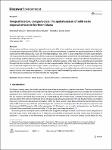Item Infomation
Full metadata record
| DC Field | Value | Language |
|---|---|---|
| dc.contributor.author | Volsuuri, Emmanuel | - |
| dc.contributor.author | Owusu-Sekyere, Ebenezer | - |
| dc.contributor.author | Imoro, Abubakari Zarouk | - |
| dc.date.accessioned | 2023-10-02T08:32:02Z | - |
| dc.date.available | 2023-10-02T08:32:02Z | - |
| dc.date.issued | 2023 | - |
| dc.identifier.uri | https://link.springer.com/article/10.1007/s44274-023-00011-3 | - |
| dc.identifier.uri | https://dlib.phenikaa-uni.edu.vn/handle/PNK/9402 | - |
| dc.description | CC-BY | vi |
| dc.description.abstract | Urban centres in Ghana continue to expand to areas with difficult accessibility, severely impacting location decisions on solid waste disposal sites (SWDS). This study uses the location theory to examine the spatial distribution of SWDS in urban Ghana. Methodologically, it uses the nearness neighbour tool, which is a key component in GIS for spatial analysis. The results show that the distribution of SWDS was clustered, randomized, and skewed. The distribution was influenced by accessibility and the ability to pay for waste management services. For these reasons, high-density populated communities were serviced through the central container collection system, while high-class residential areas benefited through the door-to-door collection system | vi |
| dc.language.iso | en | vi |
| dc.publisher | Springer | vi |
| dc.subject | SWDS | vi |
| dc.subject | Unequal location | vi |
| dc.title | Unequal location, unequal access: the spatial analysis of solid waste disposal services in Northern Ghana | vi |
| dc.type | Book | vi |
| Appears in Collections | ||
| OER - Khoa học môi trường | ||
Files in This Item:

